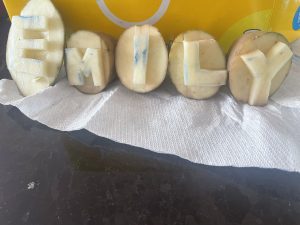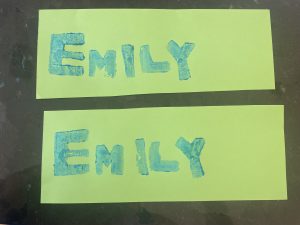Potato Printing
This was a fun activity for a rainy Sunday afternoon with my two kids. We started by discussing which letters might be the easiest letters to carve in a potato. My 8 year old pointed out that straight letters might be easier than curved. Great point! With this in mind, we decided to start with the letters in my name: EMILY. Five letters, all different and all straight – perfect!

We started by writing the letters in marker on the potato, followed the directions for carving and 20 minutes later we had 5 stamps ready to go!
 .
. 
We added the paint and carefully started stamping. We noticed as we stamped that the letters are actually backwards and we didn’t take this into account when we created the stamps. However, because of the letters that I chose it actually did not matter; with some careful maneuvering, we switched the E and the L so that they were legible on the paper. This would have been frustrating if we had chosen a letter such as G and would have had to start over. We just got lucky!
We attempted to make the copies as similar as possible and the whole process took about 40 minutes. As you can see, the paint is not perfectly even on all the letters and the letter placements are not identical or evenly spaced.

This activity allowed me to appreciate the time, effort and patience of those workers who used and continue to use printing presses. I understand why vice locks are used to keep the letters in place, as it was a challenge for me to get the right pressure and prevent the stamps from slipping. I can appreciate the time and effort that goes into creating more elaborate letter stamps than the basic letters that I chose. Finally, I understand that as the design becomes more complicated, the time and patience required increases and this needs to be reflected in the cost of the product created.
Thank you for sharing your post, Emily. Great potato letters and prints! I chose to complete this task using pencil and paper, so I’m glad to see someone do the opposite and compare our experiences.
I’m glad you shared how long it took you to complete this task. When I initially saw the option to make potato letters, I thought it would be too time-consuming. I didn’t consider why until after watching Cooke’s (2012) short film, “Upside Down, Left To Right: A Letterpress Film.” Seeing how each letter needed to be placed precisely for a piece of text to come out the way you want is an art in and of itself. Your crisp letters and careful painting to make a clear print show how much time and care you took in this process.
I also think that your experiencing the letters being backward is an excellent form of editing in this type of medium. I, too, wouldn’t have considered this. I can’t help but think of how long Cooke may take to fix an error!
For this reason, I think mechanized writing forms have been an enormous benefit. The quick editing and ability to change ideas while writing makes for a more fluid process, and I think that is ultimately why I went in this direction for my own task.
I’m left wondering how other artistic forms of writing, such as calligraphy, might influence when we choose to write by hand? Is this something that would be better done on a computer with a different font choice?
Again Emily, well done!
References
Cooke, D. (2012, January 26). Upside Down, Left to Right: A Letterpress Film. https://youtu.be/n6RqWe1bFpM
Emily, great work, and awesome that you involved your children in the process! I would have also run into the same problem with my letters as backwards when carving my potatoes.